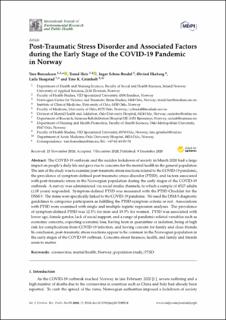| dc.contributor.author | Bonsaksen, Tore | |
| dc.contributor.author | Heir, Trond | |
| dc.contributor.author | Bredal, Inger Schou | |
| dc.contributor.author | Ekeberg, Øivind | |
| dc.contributor.author | Skogstad, Laila | |
| dc.contributor.author | Grimholt, Tine Kristin | |
| dc.date.accessioned | 2020-12-09T14:11:26Z | |
| dc.date.accessioned | 2021-02-17T10:41:49Z | |
| dc.date.available | 2020-12-09T14:11:26Z | |
| dc.date.available | 2021-02-17T10:41:49Z | |
| dc.date.issued | 2020-12-09 | |
| dc.identifier.citation | Bonsaksen T, Heir T, Bredal I, Ekeberg Ø, Skogstad L, Grimholt TK. Post-traumatic stress disorder and associated factors during the early stage of the COVID-19 pandemic in Norway. International Journal of Environmental Research and Public Health (IJERPH). 2020;17(24) | en |
| dc.identifier.issn | 1661-7827 | |
| dc.identifier.issn | 1660-4601 | |
| dc.identifier.uri | https://hdl.handle.net/10642/9590 | |
| dc.description.abstract | The COVID-19 outbreak and the sudden lockdown of society in March 2020 had a large impact on people’s daily life and gave rise to concerns for the mental health in the general population. The aim of the study was to examine post-traumatic stress reactions related to the COVID-19 pandemic, the prevalence of symptom-defined post-traumatic stress disorder (PTSD), and factors associated with post-traumatic stress in the Norwegian population during the early stages of the COVID-19 outbreak. A survey was administered via social media channels, to which a sample of 4527 adults (≥18 years) responded. Symptom-defined PTSD was measured with the PTSD Checklist for the DSM-5. The items were specifically linked to the COVID-19 pandemic. We used the DSM-5 diagnostic guidelines to categorize participants as fulfilling the PTSD symptom criteria or not. Associations with PTSD were examined with single and multiple logistic regression analyses. The prevalence of symptom-defined PTSD was 12.5% for men and 19.5% for women. PTSD was associated with lower age, female gender, lack of social support, and a range of pandemic-related variables such as economic concerns, expecting economic loss, having been in quarantine or isolation, being at high risk for complications from COVID-19 infection, and having concern for family and close friends. In conclusion, post-traumatic stress reactions appear to be common in the Norwegian population in the early stages of the COVID-19 outbreak. Concerns about finances, health, and family and friends seem to matter. | en |
| dc.language.iso | en | en |
| dc.publisher | MDPI | en |
| dc.relation.ispartofseries | International Journal of Environmental Research and Public Health;Volume 17, Issue 24 | |
| dc.rights | Creative Commons Attribution 4.0 International (CC BY 4.0) License | en |
| dc.rights.uri | https://creativecommons.org/licenses/by/4.0/ | |
| dc.subject | Coronavirus | en |
| dc.subject | Mental health | en |
| dc.subject | Norway | en |
| dc.subject | Population studies | en |
| dc.subject | Post-traumatic stress disorders | en |
| dc.title | Post-traumatic stress disorder and associated factors during the early stage of the COVID-19 pandemic in Norway | en |
| dc.type | Journal article | en |
| dc.type | Peer reviewed | en |
| dc.date.updated | 2020-12-09T14:11:26Z | |
| dc.description.version | publishedVersion | en |
| dc.identifier.doi | https://doi.org/10.3390/ijerph17249210 | |
| dc.identifier.cristin | 1857162 | |
| dc.source.journal | International Journal of Environmental Research and Public Health (IJERPH) | |

